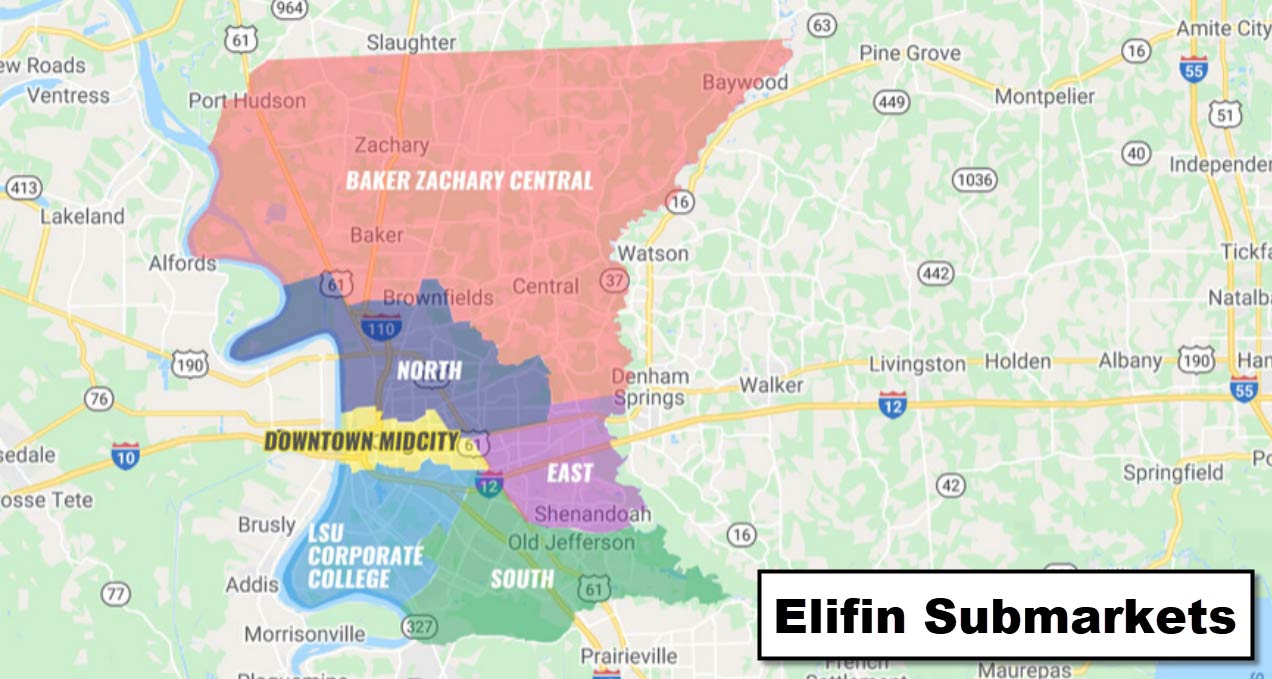
28 Feb The Right and Wrong Way to Divide a Market into Submarkets
Has anyone ever attempted to create submarkets?
When analyzing trends in a real estate market, it can be very helpful to divide that market into submarkets because stats such as sale prices and transaction volume can differ greatly from one pocket of a Parish / County to another.
Here are the submarkets Elifin Realty created for one of our recent research reports (view at MakeGreatDeals.com).
Anyone can circle a certain pocket of industrial buildings and call it the “Industriplex” submarket. That’s easy.
But what about splitting up an entire Parish/County so that every square inch of the geography is accounted for and the submarkets remain relevant as you evaluate different property types? It’s a difficult task.
Here are some potential ways to divide up a market and why they’re a bad choice:
 RESIDENTIAL MLS AREAS – Often the dividing line between the residential MLS areas are major highways. In commercial, submarkets are frequently defined by those very thoroughfares and to have one side of the street in one submarket and the other side in another…. is problematic.
RESIDENTIAL MLS AREAS – Often the dividing line between the residential MLS areas are major highways. In commercial, submarkets are frequently defined by those very thoroughfares and to have one side of the street in one submarket and the other side in another…. is problematic.
 CREATE YOUR OWN – You could create your own submarkets based on what you feel are the right boundaries… the issue is that it’s very inflexible and time consuming when you want to drill down further or revise submarket boundaries and apply it to historical data.
CREATE YOUR OWN – You could create your own submarkets based on what you feel are the right boundaries… the issue is that it’s very inflexible and time consuming when you want to drill down further or revise submarket boundaries and apply it to historical data.
 ZIP CODES – A solid option because all of your property address data already contains a zip code and thus is already categorized! That takes a load off. And you can combine zip codes to make larger submarkets or break it out if you’d like to. The major drawback besides seemingly arbitrarily created boundaries that aren’t as relevant today as they perhaps once were? You can only drill down so far. If you wanted to look at just the data in the Baton Rouge CBD for example, you couldn’t do that by taking the zip codes 70801 and 70802…. because those zip codes encompass a much larger area.
ZIP CODES – A solid option because all of your property address data already contains a zip code and thus is already categorized! That takes a load off. And you can combine zip codes to make larger submarkets or break it out if you’d like to. The major drawback besides seemingly arbitrarily created boundaries that aren’t as relevant today as they perhaps once were? You can only drill down so far. If you wanted to look at just the data in the Baton Rouge CBD for example, you couldn’t do that by taking the zip codes 70801 and 70802…. because those zip codes encompass a much larger area.
The solution?

CENSUS BLOCK GROUPS – There are online sites where you can bulk geo code your addresses into census block groups. You then assign census block groups into your desired submarkets. If you ever want to change, expand, or hone in a submarket further… all you have to do is redefine which census block groups fall under your new submarket name and then all of your historical data will align with your new submarkets.
The census block groups have the added benefit of being able to be paired with all of the census data.



No Comments